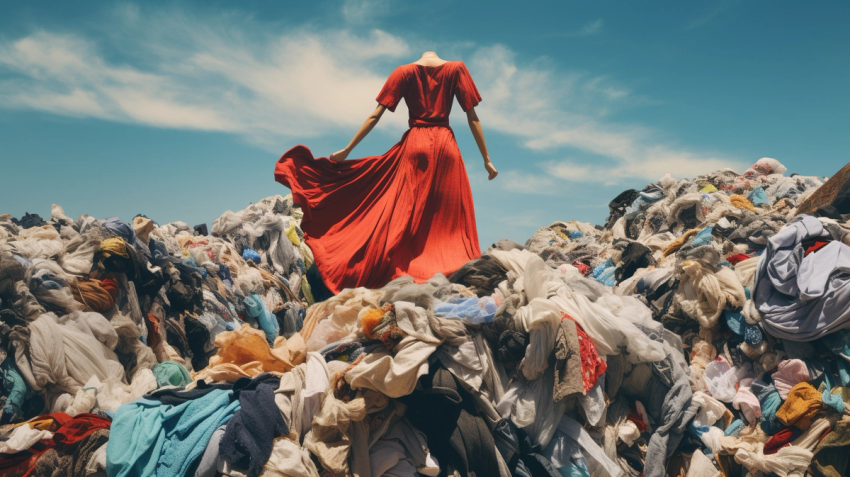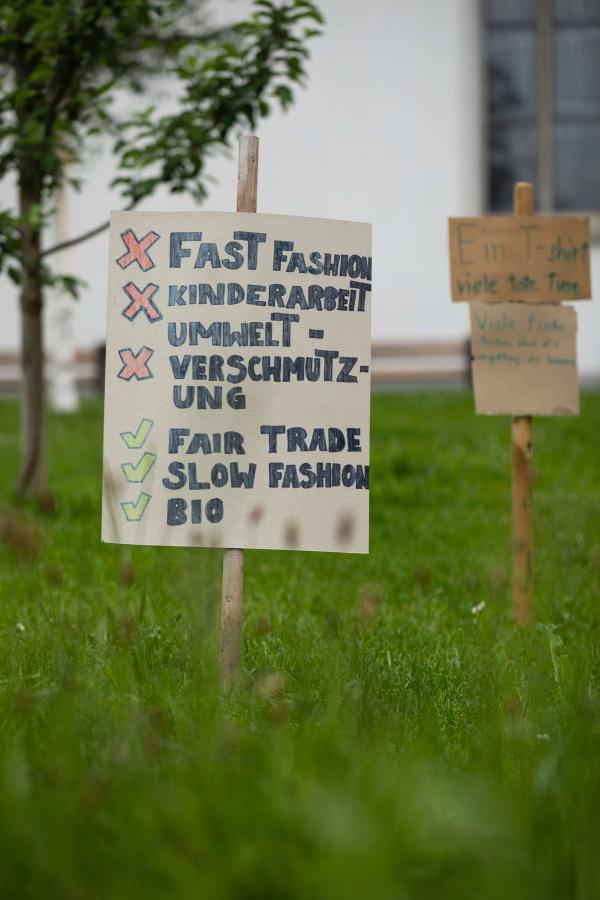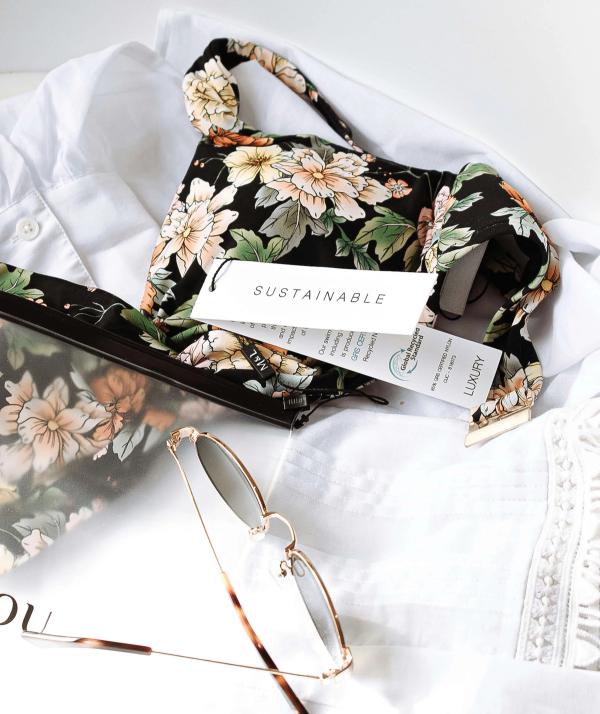92 Mind-blowing Sustainable Fashion Facts You Should Know (2024)

By Christie Johnson

Knowledge is power – especially when choosing how we shop and care for our clothing.
You’ve probably heard the term “sustainable fashion” floating around. It's a phenomenon that was once a faint whisper but is now shouted from the sartorial rooftops by individuals and brands alike.
But what does it actually mean? And how does it differ from fast fashion? Is it even possible to consume clothing more consciously?
In this article, you’ll discover the most recent and official sustainable fashion facts and statistics.
Our findings delve into the latest industry data, trends and forecasts.
You can also learn about the devastating impacts of the fast fashion industry and simple ways you can make more sustainable fashion choices.
Are you ready to be part of the sustainable fashion revolution? Let’s dive in.
The Latest Sustainable Fashion Facts and Stats
What is Sustainable Fashion?
Sustainable fashion is clothing made with deep consideration for people and the environment. Garments made sustainably and ethically cause minimal environmental harm. They also ensure the well-being of humans and animals across every aspect of the supply chain.
In other words, sustainable fashion is the direct antithesis of fast fashion. More on this later!
What is the Growth Rate of Sustainable Fashion?
- The stats are in – sustainable fashion is on the rise! The market is currently worth $8.16 billion globally. Projections say it could reach around $10 billion by 2025 and $33.05 billion by 2030.
- The compound annual growth rate (CAGR) of the ethical fashion market is forecast to reach 8.6% between 2027 - 2032.
- The sales share of sustainable clothing has increased over the last decade. It is forecast to reach over 6% by 2026.
- Asia Pacific held the largest global share of the ethical fashion market (33%). Eastern Europe and South America are now considered the fastest-growing regions. The market growth for each area is at CAGRs of 12.5% and 10.3% respectively.
- The men’s ethical fashion market is expanding at an exponential rate. It’s forecast to surpass the female and child segments by a CAGR of 8.3% during 2022 – 2027.
- A fully-fledged sustainable textile industry could create 18 million jobs globally by 2030!
- Now is the time to invest in sustainable raw materials. Fashion brands could unlock an estimated average of 6% profit uplift after 5 years.
Who Cares about Sustainable Fashion?
- 78% of US consumers say a sustainable lifestyle is important to them.
- Younger generations in the US are by far the biggest sustainable fashion consumers. Millennials make up over two-fifths of the market closely followed by Gen Z.
- Most online sustainable product purchases in Afterpay are by Gen Z and Millennials, accounting for 69% of the share of spend.
- Three-fifths of American shoppers say an apparel’s sustainability credentials are at least slightly important when replenishing their wardrobes.
- British males between 25-44 are more likely to buy from sustainable fashion brands.
- So, does this mean females are less interested in making conscious fashion choices? On the contrary! 71% of UK Gen Z females note sustainability as an integral purchasing factor. It still doesn't deter 54% from shopping at fast fashion retailer Shein.
- Environmental concerns are top of mind for US consumers. Around 43% consider protecting nature as their core reason for ditching fast fashion.
- Over the last 5 years, 25% of US shoppers have increased their eco-conscious purchases.
- 30% of fashion consumers in the United States have tried a new product in the name of sustainability.
- Sustainability would increase brand loyalty for 34% of UK consumers.
- Conscious consumerism is on the rise in Southeast Asia. 86% of shoppers in Vietnam and 42% in Singapore invest in sustainable fashion products.
- 67% of consumers consider sustainable materials as an important purchasing factor.
- 54% of US fashion shoppers feel confused when identifying sustainable fashion items.
- 50% of Latin American and Asian consumers feel sustainable products are hard to find.
Sustainable Fashion Trends That May Surprise You

Thrifty is the New Trendy
Has frugal become more fashionable?
The world feels confusing and fragmented right now. From high inflation to unrelenting geopolitical turmoil, it's no wonder consumers feel dubious and under pressure right now!
So, what does this mean for sustainable fashion? Conscious shopping is still top of mind for many shoppers. Yet the gap between ideals and practice is palpable as hard times continue to endure. Sartorial savings – for the most part – seem to be taking precedence.
- Consumers plan to reduce how much they spend on clothing in 2024. Net intent to spend on apparel over 3 months is –29% in Europe and –25% in the United States.
- Almost 61% of consumers have a strong desire to buy eco-friendly products. Yet many view higher price points as the main barrier to shopping sustainably.
- 96% of UK consumers are prioritizing affordability over sustainability.
- Over 75% of US Gen Zers and Millennials are tightening their belts when buying apparel and beyond.
- You’d think record inflation would be driving consumers towards cheap fast fashion, right? Higher prices are actually encouraging 52% of UK consumers to develop a sustainable fashion mindset. Think buying less, shopping second hand and the occasional investment in high-quality staples.
- Resale is all the rage. The second-hand clothing industry is growing 3X faster on average than new apparel. This means the market could be worth an astonishing $350 billion by 2027!
- Gen Z has a particular passion for preloved. 83% state they have bought – or are willing to buy – second-hand clothing.
- Take-back, rental and repair schemes are becoming popular choices for fashion consumers. Resale clothing programmes currently have a 3.4X year-over-year growth rate.
- Despite global financial pressures, Gen Zers in California are still willing to pay a 15% premium for clothes made from recycled materials.
- Similarly, one-quarter of US shoppers somewhat agreed they would pay more for sustainable fashion items.
A Circular Fashion World
Nature operates the perfect circular system. All species and natural processes are innately regenerative.
Consider a leaf. When it falls from a tree it provides nutrients to the forest floor. Everything in nature is utilized. Human beings are the only wasteful creatures on the planet.
So why are we the outliers? Man-made systems like the fashion industry follow a linear – and extremely lucrative – production process. Humanity’s “take-make-dispose” model is profoundly polluting and unleashes untold social and environmental devastation.
Isn’t it about time we took a leaf out of nature’s book? The sustainable fashion movement certainly thinks so!
Many clothing brands are working towards circular fashion solutions. Think renewable energy, clothing use, scaled-up textile recycling and regenerative materials!
- Circular business models could create $560 billion worth of economic opportunity. This means it could account for around 23% of the global fashion market by 2030.
- Textile-to-textile recycling is forecast to become commercially scalable as technical innovation and investor interest grow. At the moment, only 1% of used textiles are transformed into new clothing.
- It’s estimated that 70% of textile waste could follow a closed-loop recycling method by 2030.
- The global textile recycling market was worth approximately $4.1 billion in 2022. It's projected to grow to $5.3 billion by 2030.
- 54% of consumers expect to buy more clothes made from recycled materials.
- 92% of consumers are willing to take part in brand-sponsored clothes recycling initiatives.
- 60% of UK textile materials in circulation can be recycled. This means a closed-loop process is achievable with the right sorting infrastructure.
- Despite mounting public pressure, only 9% of major fashion brands disclose how they plan to switch to renewable energy.
Next-Gen Materials
A throng of cheap and unsustainable materials permeates our wardrobes. Why? Because major fashion retailers have one goal: keep costs low and profits high. And using low-cost synthetic and non-organic materials is one surefire way to keep fashion fruitful.
But the overproduction of these flawed fabrics is leaving ecosystems and communities hanging by the thread. The solution? Say hello to next-gen materials!
Plant-derived, mycelium, recycled materials, microbes, cultivated animal cells – the possibilities are truly endless.
- 102 companies are now specializing in next-gen materials. The industry has received $3 billion worth of investment since 2013.
- 78% of US consumers are willing to pay the same or higher for apparel made from next-gen materials.
- The global plant-based leather market is forecast to reach $97 million by 2027.
- Piñatex derived from pineapple waste is currently worth $63.8 million. It’s expected to rise to $108.7 million by 2031. Over 1,000 major fashion retailers are using Piñatex from Hugo Boss to H&M.
- Next-gen materials are likely to account for over half of the market share. 54% of leather; 57% of wool; 60% of silk; 61% of down; 66% of fur, and 63% of exotic skins.
- “Preferred materials” now represent 56% of fashion materials. This includes organic cotton and recycled synthetics.
Greenwashing Crackdown
It’s time to address the green elephant in the room. Not all fashion brands are serious about their sustainability claims!
Greenwashing – or “green sheen” – is a deceptive marketing tactic used to make companies appear more sustainable than they actually are. And it's a problem that’s rife across the fashion industry.
Although green may be the new black, vague and inconsistent eco statements simply won’t fly with today’s younger consumers.
- 79% of fashion leaders see strict standards to assess sustainability performance as a critical barrier to improving consumer perception.
- Fashion brands are notorious for jumping on the green bandwagon. 39% of green claims in the textile, garment and shoe industry could be false or deceptive.
- 47% of UK consumers agreed false or misleading sustainability statements would deter them from investing in a fashion brand.
- 51% of major fashion brands publish targets on sustainable fashion. Yet only 44% explicitly define what they mean by “sustainable”.
- A staggering 88% of US Gen Zers are dubious of a fashion brand’s environmental, social and governance (ESG) claims.
- Only 9% of Australian consumers believe fashion brands are transparent about how sustainable and ethical their products are.
A New Age of Sustainable Fashion Regulations
Could legislation be the answer to an unsustainable fashion world?
As many as 16 new sustainability-linked regulations are coming into force around the world.
87% of fashion executives expect sustainability regulations will impact their businesses in 2024. This unprecedented wave of regulations could transform the fabric of the fashion industry forever!
Here are just a few groundbreaking examples to give you a sense of things to come.
Digital Product Passports (DDP)
With new regulation comes new revolutionary technology.
The European Commission is rolling out a digital labeling initiative in the form of a QR code. It’s a powerful tool that tracks the entire lifecycle of a product and reveals important sustainability information to shoppers.
The DDP will play out in EU markets but still applies to all products produced outside of the continent.
Green Claims Directive
In an age of greenwashing, it can feel impossible to approach conscious shopping with confidence. When terms like “eco-friendly” and “sustainable” are so freely used by brands, how can you separate the greenwashing fluff from legitimate claims?
Enter the Green Claims Directive!
Introduced by the European Commission, the Green Claims Directive is a series of strict universal regulations that will compel businesses to evidence their green credentials. This will hopefully empower consumers to make better choices for themselves and the planet.
The FABRIC Act
The Fashioning Accountability and Building Real Institutional Change (FABRIC) Act is designed to protect workers’ rights across the US garment sector. It aims to create safe and fair working conditions. This would include enforcing the minimum wage and combating factory violations.
The Fashion Act
The Fashion Act is another pioneering piece of US legislation.
If passed, the law would compel fashion brands to disclose all aspects of the supply chain. They would also take full responsibility for improving environmental and ethical practices.
Why is Sustainable Fashion So Important?

Sustainable fashion is so important because fast fashion is so devastating.
Fast fashion dominates our wardrobes, high-street stores and online shopping platforms. Over the last 30 years, traditional slow fashion principles buckled under the allure of cheap clothing and rapid new styles.
Yet this greedy business model comes at a huge cost to the environment and the people who work across the industry’s bloated supply chains.
What is the Environmental Footprint of Fast Fashion?
- The fashion industry contributes to approximately 10% of annual global greenhouse gas emissions.
- Fashion production generates around 1.2 billion tonnes of carbon dioxide annually.
- The industry is the second largest polluter in the world. It produces more carbon emissions than all international flights and maritime shipping!
- Between 100 – 150 billion new clothes are produced every year and 92 billion tons of fashion waste is dumped into landfill.
- Clothes manufacturing requires 79 trillion liters of water every year.
- Textile dyeing and treatment contribute to 20% of the world’s wastewater.
- Fast fashion’s linear supply chain means over $500 billion worth of textiles is wasted every year.
- What really happens to the clothes you donate? As low as 10-30% of second-hand clothing is resold in the country where it was collected. Approximately 75% is sent to the Global South.
- 20-50% of used clothing bales sent to the Global South are unsalable. This means many countries in these regions are shouldering unmanageable waste problems.
- The textile industry contributes to approximately 35% of microplastic pollution in the ocean.
- Affordable price tags and tempting new trends have created a toxic throwaway culture. The wearability of clothing has declined by 36% in 15 years.
- It’s estimated the average fashion consumer buys 60% more clothes than they did in the year 2000.
- The average fashion consumer only wears a garment 7 to 10 times before tossing it.
How Does Fast Fashion Impact Human Health?
- Textile production has almost quadrupled since 1975.
- The world produces 113.8 million metric tons of textile fibers every year. 87.6 million of those are chemical synthetic fibers.
- Around 8,000 synthetic chemicals form part of the garment manufacturing process. A cocktail of toxic chemicals is often thrown into the mix from PFAS and BPA to formaldehyde and Azo dyes.
- Despite reports of toxic residues lingering on our clothes, only 51% of major fashion brands publish restricted substance lists.
How are Human Rights Violated in Fast Fashion?
- Garments are the second highest at-risk product category of modern slavery.
- Although 52% of major fashion brands reveal their first-tier supplier lists, only 1% disclose if workers are paid a living wage.
- 45% is the average industry pay gap between minimum and living wage for major garment-producing countries.
- Garment workers earn on average 2-5 times less than what they need to support themselves and their families with dignity.
- 85% of the top fashion brands publish policies outlining their commitment to freedom of association, the right to organize and collective bargaining across their supply chains.
- Only 39% of brands state how they are implementing the above policies.
- The garment-making industry provides 94 million jobs worldwide.
- Asia employs 75% of garment workers globally and 42 million garment workers are women.
- Bangladesh recently increased the minimum monthly wage for garment workers by 56% (12,500 taka/$113). However, soaring food prices and record-breaking inflation mean workers still struggle to make ends meet. The decision came after weeks of desperate and violent protests.
Is Ultra-Fast Fashion Taking Over?
Is it true? Is fast fashion getting faster?
It almost beggars belief the industry could reach greater heights of success. It’s especially hard to comprehend when fast fashion leaders like H&M and Zara turn over billions of dollars every year.
But there is a new and faster trend in town that's keeping first and second-generation fast fashion on its toes.
Ultra-fast fashion is taking everything that's wrong with regular fast fashion and turning up the speedometer. This means even more styles. Even cheaper price tags. Even greater exploitation. If you can fathom it!
- Chinese-founded ultra-fast fashion giant Shein dominated 50% of US fashion sales in 2022. H&M and Zara fell behind at 16% and 13%, respectively.
- Temu is the latest Chinese ultra-fashion sensation. It passed Amazon as the most downloaded shopping app in the US only months after launching.
- Shein’s revenue surged to $24 billion between January and September 2023. This means Shein could surpass Zara and H&M.
- 40% of US consumers and 26% of UK consumers have shopped at Shein or Temu in the past 12 months.
- Shein’s average SKU price of $14 is significantly lower than H&M’s $26 and Zara’s $34.249.
- The hashtag #sheinhaul has become a TikTok sensation and started the fast fashion haul craze in 2022. Videos with the hashtag accumulated 4.8 billion views!
- Fast fashion competition is set to be fiercer than ever in 2024. This new generation is changing its tactics around pricing, customer experience and speed.
- 1 in 3 Gen Zers say they feel addicted to fast fashion and 45% say it’s hard to resist the temptation of new trends.
Is the Future of Fast Fashion On the Rocks?
2023 was the hottest year on record. Extreme wildfires, flooding, storms and droughts ravaged ecosystems and communities.
Many fast fashion supply chains are situated directly in the climate crisis line of fire. Are major brands doing enough to build resilience?
- By 2030, over $65 billion of clothing exports are at risk of being destroyed by climate events.
- 67% of global cotton and 52% of global apparel exports are already highly affected by climate disasters.
- Major retailers seem to view the climate crisis as a future problem. Reports show fashion executives expect other challenges such as economic uncertainty, geopolitical tensions and inflation to take precedence over climate risk in 2024.
- Fast fashion retailers could face revenue declines of 10-30% over the next 5-10 years. This is mostly due to consumers developing an eco-conscious mindset.
- Can fast fashion outpace new sustainability regulations? 2024 is forecast to be a challenging year as consumers and regulators demand change.
How You Can Make Sustainable Fashion Choices

Calling all conscious consumers!
Does your love of ethics outweigh the latest fashion fads? If so, keep scrolling!
Now that we’ve established the sustainable fashion facts, here are a few simple ways you can embrace a conscious fashion mindset.
Consider Sustainable Fashion Certifications
Sustainable certifications are voluntary standards issued by an independent third party. They are handy tools that can help you determine if a brand is truly sustainable and ethical.
Here are just a few important certifications to look out for as a conscious fashion consumer.
The Global Organic Textile Standard (GOTS)
- A worldwide leading textile processing standard for organic fibers (75% or 95% depending on the label)
- Eliminates hazardous chemicals
- Maintains ethical treatment of workers
OEKO-TEX®
- OEKO-TEX® STANDARD 100 label signifies textiles that are free from harmful substances
- OEKO-TEX® MADE IN GREEN label signifies textiles and leather goods that are free from harmful substances and made in an eco-friendly and ethical way
SA8000
- An international standard that protects human rights and maintains high ethical standards across the supply chain
- Prohibits child or forced labor
- Guarantees a living wage and safe working conditions
- Permits free association and collective bargaining
Fairtrade International
- Empowers farmers and workers to have more control over their lives
- Protects workers’ rights
- Ensures fair prices and 100% traceability
- Maintains strict environmental standards
- No GMOS, minimizes agrochemicals, safe management of waste, soil fertility and water
Explore Slow Fashion Brands
Leaving the fast fashion lane in pursuit of slower alternatives can feel overwhelming. But it doesn't have to be!
Investing in slow or sustainable brands is a powerful way to reduce your impact. And because sustainable garments are all about longevity, you can even save some time and money too.
Here are a few slow fashion principles to look out for:
- Garments are versatile and timeless collections you can wear across the seasons. The idea is that you only need to invest in a few staples that will last you a lifetime!
- Garments are made from high-quality materials with a low environmental impact. For example, TENCEL™ lyocell, organic cotton and linen.
- Clothing is made ethically and sometimes locally.
- Brands only make small batches and often follow made-to-order business models.
- Essentially, slow fashion is everything fast fashion is not!
Pressed for time? Here’s a quick round-up of the best and most sustainable capsule wardrobe brands you should check out!
Research, Research, Research!
It’s time to start asking questions.
If you’re looking to buy from a fashion brand, get to know their mission and values. What do they stand for?
Also consider:
- Where are their clothes made and who makes them?
- Where do their materials come from? Do they use hazardous chemicals?
- How do they minimize their carbon and water footprint?
- What are their policies on waste management?
Increasing your awareness will help you decide if a brand is a worthwhile investment!
Pro tip: Directories like Good On You are a great place to start when finding out a garment’s green credentials. If you can’t find the answers yourself, why not contact the brand directly?
Need some help finding the best brands? Check out our top 5 tips to find sustainable fashion brands for 2024 and beyond.
Embrace Circularity
Keeping your clothes in circulation is at the heart of sustainable fashion.
And it's actually easier and cheaper than you might think. Here are a few ideas to get you started:
Shop your closet.
The first rule of circularity is reviewing what you already own. What haven't you worn in a while? What could you mix and match? Let go of the idea of seasonal and occasional wear. Layer summer dresses with chunky winter jumpers. Could your workwear be "dressed down" with sneakers?
Pro tip: If you need a little more inspiration, check out our guide to creating the ultimate eco-capsule wardrobe.
Make Do and Mend
When clothes are so cheap, it's often easier to throw away rather than repair what you own.
Yet it wasn't that long ago when mending was the norm and buying new was the exception! Next time the zip is broken on your jacket or you have a hole in your pants, why not try to keep them in circulation for a while longer?
Don't possess the darning skills? Don't worry! You can always take a trip to your local tailor.
Choose Preloved
With the rise of online platforms like thredUP and Vinted, it's never been easier to shop second-hand. But don't forget: second-hand shopping isn't like fast fashion. Finding the perfect preloved item can take some time.
Pro tip: As vintage sizes can vary, it’s always best to have your measurements to hand. Try shopping out of season to avoid demand and always remember to keep an open mind!
Interested in learning more? Check out our guide on how to reduce waste and carbon footprint in sustainable fashion.
Sustainable Fashion Facts: The Bottom Line
So that’s a wrap on the latest sustainable fashion facts!
It's hard to avoid the unrelenting fast fashion frenzy that dominates modern life.
Buying into new trends is affordable and addictive. It's familiar and attainable.
Fast – and ultra-fast – fashion is still a booming industry. Yet it's hard to ignore the overwhelming sense of positive change in the air!
Sustainable fashion is growing. Legislation is on the horizon. Next-gen materials could replace unsustainable fabrics. Fashion shoppers are demanding transparency over trends. Principles are taking precedence over price tags. Values are in, vogue is out.
Will the fashion status quo be completely turned on its head? Only time will tell.
What do you think? Could this be the start of a new age of sustainable fashion? Follow us at @madewildr and let us know!
Sign up to our newsletter for the latest trends, brands, and and tips for a sustainable lifestyle.
Sources:
Coherent Marketing Insights | Research & Markets | Gitnux | Boston Consulting Group | Square & Afterpay | Mintel | Deloitte | Kantar | Untold Insights | Zion Market Research | Changing Markets Foundation | Valpak | Markets and Markets | Transparency Market Research | Ananas Anam | Textile Exchange | Sustainable Brand Platform | Frontiers | The World Bank | Research Gate | Plastic Soup Foundation | European Environment Agency | Wage Indicator | Clean Clothes Campaign | International Labour Organization | Aljazeera | UBS | Material Innovation Initiative | Fashion Revolution Index | Fashion Revolution Impact Report | Ellen MacArthur Foundation | thredUP | McKinsey The State of Fashion 2023 | McKinsey and NielsenIQ | McKinsey Scaling Textile Recycling | McKinsey A New Fashion Forumula | ScienceDirect Antimony release from polyester textiles | ScienceDirect Sustainable Chemistry | UN Environment Programme | UN | Statista Ethical Fashion Market | Statista Sustainable Apparel Global Revenue Share | Statista US Sustainable Apparel Market Share | Statista Importance of Sustainability to Consumers | Statista UK Sustainable Fashion Choice Demographic | Statista Drivers of Sustainable Fashion Purchases | Statista US Shift to Buying Sustainable Products | Statista US Sustainability Conscious Fashion Purchase Changes | Statista SEA Sustainable Fashion Purchases | Statista Confusion Over Sustainability Purchases | Statista US Consumers Willingness to Pay More Sustainable Fashion | Statista Australia Consumer Views Sustainable Fashion | Statista Greenwashing | Statista Worldwide Textile Production Volume | Statista Asia Pacific Apparel Market | Statista Shein Hauls | Mckinsey The State of Fashion 2024 | The Information | Gen Z Fast Fashion Report



